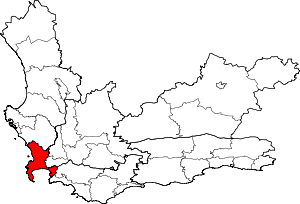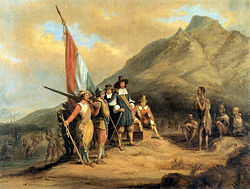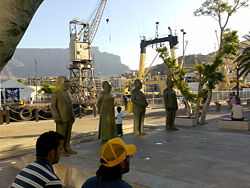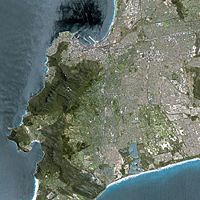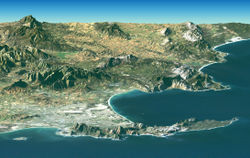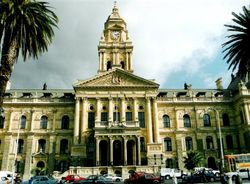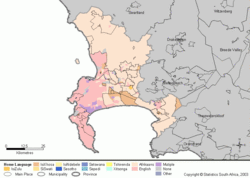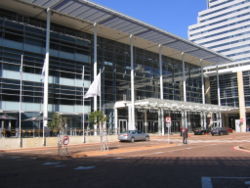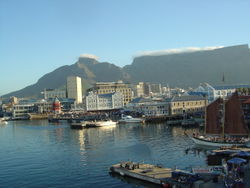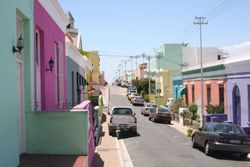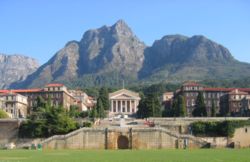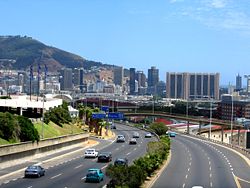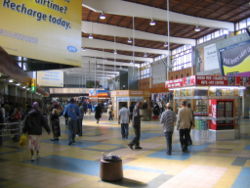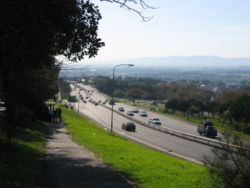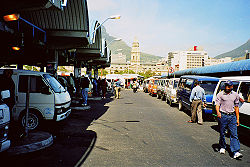Cape Town
2008/9 Schools Wikipedia Selection. Related subjects: Africa; Cities
| Cape Town (English) Kaapstad (Afrikaans) iKapa (Xhosa) |
|||
| Panorama of the Cape Town city bowl from the Waterfront to Table Mountain | |||
|
|||
| Nickname: The mother city, or The Tavern of the Seas | |||
| Motto: Spes Bona (Latin for "Good Hope") | |||
| Location of the City of Cape Town in Western Cape Province | |||
| Coordinates: | |||
|---|---|---|---|
| Country | South Africa | ||
| Province | Western Cape Province | ||
| Municipality | City of Cape Town Metropolitan Municipality | ||
| Founded | 1652 | ||
| Government | |||
| - Type | City council | ||
| - Mayor | Helen Zille | ||
| - City manager | Achmat Ebrahim | ||
| Area | |||
| - Total | 2,454.72 km² (947.8 sq mi) | ||
| Population (2007) | |||
| - Total | 3,497,097 | ||
| - Density | 1,425/km² (3,690.7/sq mi) | ||
| Time zone | SAST ( UTC+2) | ||
| Postal code | 8000 | ||
| Area code(s) | +27 (0)21 | ||
| Website: http://www.capetown.gov.za/ | |||
Cape Town (Afrikaans: Kaapstad; Xhosa: iKapa) is the second most populous city in South Africa, forming part of the metropolitan municipality of the City of Cape Town. It is the provincial capital of the Western Cape, as well as the legislative capital of South Africa, where the National Parliament and many government offices are located. Cape Town is famous for its harbour as well as its natural setting in the Cape floral kingdom, including such well-known landmarks as Table Mountain and Cape Point. Cape Town is one of the most popular South African destinations for tourism.
Cape Town was originally developed as a victualling (supply) station for Dutch ships sailing to Eastern Africa, India, and the Far East more than 200 years before the construction of the Suez Canal in 1869. Jan van Riebeeck's arrival on 6 April 1652 established the first permanent European settlement in South Africa. Cape Town quickly outgrew its original purpose as the first European outpost at the Castle of Good Hope. It was the largest city in South Africa until the growth of Johannesburg.
According to the 2007 Community Survey, the city has a population of 3.5 million. Cape Town's land area of 2,455 square kilometres (948 sq mi) is larger than other South African cities, resulting in a comparatively lower population density of 1,425 people per square kilometre (3,689/sq mi). Cape Town is twinned with Nice in France and Haifa in Israel.
History
There is no certainty as to when humans first occupied the area prior to the first visits of Europeans in the 15th century. The earliest known remnants in the region were found at Peers cave in Fish Hoek and date to around 12,000 years ago. Little is known of the history of the region's first residents, since there is no written history from the area before it was first mentioned by Portuguese explorer Bartolomeu Dias in 1486. Vasco da Gama recorded a sighting of the Cape of Good Hope in 1497, and the area did not have regular contact with Europeans until 1652, when the Netherlands' Jan van Riebeeck and other employees of the Dutch East India Company (Dutch: Verenigde Oost-indische Compagnie, VOC) were sent to the Cape to establish a way-station for ships travelling to the Dutch East Indies. The city grew slowly during this period, as it was hard to find adequate labour. This labour shortage prompted the city to import slaves from Indonesia and Madagascar. Many of these became ancestors of the first Cape Coloured communities.
During the French Revolutionary and Napoleonic wars, the Netherlands was repeatedly occupied by France, and Great Britain moved to take control of Dutch colonies. Britain captured Cape Town in 1795, but the Cape was returned to the Netherlands by treaty in 1803. British forces occupied the Cape again in 1806. In the Anglo-Dutch Treaty of 1814, Cape Town was permanently ceded to Britain. It became the capital of the newly formed Cape Colony, whose territory expanded very substantially through the 1800s.
The discovery of diamonds in Griqualand West in 1869, and the Witwatersrand Gold Rush in 1886, prompted a flood of immigrants to South Africa. Conflicts between the Boer republics in the interior and the British colonial government resulted in the Second Boer War of 1899-1901. Britain won the war. In 1910, Britain established the Union of South Africa, which unified the Cape Colony with the two defeated Boer Republics and the British colony of Natal. Cape Town became the legislative capital of the Union, and later of the Republic of South Africa.
In the 1948 elections, the National Party won on a platform of apartheid (racial segregation) under the slogan of swart gevaar. This led to the Group Areas Act, which classified all areas according to race. Formerly multi-racial suburbs of Cape Town were either purged of unlawful residents or demolished. The most infamous example of this in Cape Town was District Six. After it was declared a whites-only region in 1965, all housing there was demolished and over 60,000 residents were forcibly removed. Many of these residents were relocated to the Cape Flats and Lavendar Hill. Under apartheid, the Cape was considered a " Coloured labour preference area", to the exclusion of " Bantus", i.e. blacks.
Cape Town was home to many leaders of the anti-apartheid movement. On Robben Island, a penitentiary island 10 kilometres out to sea from the city, many famous political prisoners were held for years. In one of the most famous moments marking the end of apartheid, Nelson Mandela made his first public speech in decades on 11 February 1990 from the balcony of Cape Town City Hall hours after being released. His speech heralded the beginning of a new era for the country, and the first democratic election was held four years later, on 27 April 1994. Nobel Square in the Victoria & Alfred Waterfront features statues of South Africa's four Nobel Peace Prize winners - Albert Luthuli, Desmond Tutu, F.W. de Klerk and Nelson Mandela. Since 1994, the city has struggled with problems such as HIV/AIDS, tuberculosis, a surge in violent drug-related crime and more recent xenophobic violence. At the same time, the economy has surged to unprecedented levels due to the boom in the tourism and the real estate industries.
Geography
The centre of Cape Town is located at the northern end of the Cape Peninsula. Table Mountain forms a dramatic backdrop to the city bowl, with its plateau over 1,000 m (3,300 ft) high; it is surrounded by near-vertical cliffs, Devil's Peak and Lion's Head. Sometimes a thin strip of cloud forms over the mountain, and owing to its appearance, it is colloquially known as the "tablecloth". The peninsula consists of a dramatic mountainous spine jutting southwards into the Atlantic Ocean, ending at Cape Point. There are over 70 peaks above 1,000 feet (300 m) (the American definition of a mountain) within Cape Town's official city limits. Many of the suburbs of Cape Town are on the large plain of the Cape Flats, which joins the peninsula to the mainland. The Cape Flats lie on what is known as a rising marine plain, consisting mostly of sandy geology which shows that at one point Table Mountain itself was an island.
Climate
The Cape Peninsula has a Mediterranean climate with well-defined seasons. In winter, which lasts from May to September, large cold fronts come across from the Atlantic Ocean with heavy precipitation and strong north-westerly winds. The winter months are cool, with an average minimum temperature of 7 ° C (45 ° F). Most of the city's annual rainfall occurs in wintertime, but due to the mountainous topography of the city, rainfall amounts for specific areas can vary dramatically. The suburb of Newlands which is to the south of the city is the wettest place in South Africa. The valleys and coastal plains average 515 millimetres (20 in) of rain per annum, while mountain areas can average as much as 1,500 millimetres (60 in) per annum. Summer, which lasts from November to March, is warm and dry. The Peninsula gets frequent strong winds from the south-east, known locally as the Cape Doctor, because it blows away pollution and cleans the air. The south-easterly wind is caused by a high-pressure system which sits in the South Atlantic to the west of Cape Town, known as the South-Atlantic High. Summer temperatures are mild, with an average maximum of 26 °C (79 °F). The only times when Cape Town can be uncomfortably hot is when the Berg Wind, meaning "mountain wind" blows from the Karoo interior for a couple weeks in February or early March.
| Weather averages for Cape Town | |||||||||||||
|---|---|---|---|---|---|---|---|---|---|---|---|---|---|
| Month | Jan | Feb | Mar | Apr | May | Jun | Jul | Aug | Sep | Oct | Nov | Dec | Year |
| Record high °C (°F) | 39 (102) | 38 (100) | 41 (106) | 39 (102) | 34 (93) | 30 (86) | 29 (84) | 32 (90) | 33 (91) | 37 (99) | 40 (104) | 35 (95) | 41 (106) |
| Average high °C (°F) | 26 (79) | 27 (81) | 25 (77) | 23 (73) | 20 (68) | 18 (64) | 18 (64) | 18 (64) | 19 (66) | 21 (70) | 24 (75) | 25 (77) | 22 (72) |
| Average low °C (°F) | 16 (61) | 16 (61) | 14 (57) | 12 (54) | 9 (48) | 8 (46) | 7 (45) | 8 (46) | 9 (48) | 11 (52) | 13 (55) | 15 (59) | 11 (52) |
| Record low °C (°F) | 7 (45) | 6 (43) | 5 (41) | 2 (36) | 1 (34) | -1 (30) | -1 (30) | 0 (32) | 0 (32) | 1 (34) | 4 (39) | 6 (43) | -1 (30) |
| Precipitation mm (inches) | 15 (0.6) | 17 (0.7) | 20 (0.8) | 41 (1.6) | 69 (2.7) | 93 (3.7) | 82 (3.2) | 77 (3) | 40 (1.6) | 30 (1.2) | 14 (0.6) | 17 (0.7) | 515 (20.3) |
| Source: 2008-06-04 | |||||||||||||
Government
Cape Town's local government is the City of Cape Town, which is a metropolitan municipality. Cape Town is governed by a 210-member city council, which reports to a 28-member executive council. The executive council, in turn, is presided over by a city manager and an executive mayor. The city is divided into 105 electoral wards; each ward directly elects one member of the council, whilst the other 105 councillors are elected by a party-list proportional representation system. The mayor is chosen by the city council.
The current mayor is Helen Zille of the Democratic Alliance. In the most recent local government elections, the Democratic Alliance was the largest single party with 90 of the 210 seats on the council, ahead of the African National Congress's 81 seats, but with no party holding a majority. A subsequent by-election has increased the DA's seats to 91. The DA has now increased its majority, by introducing the Independent Democrats (South Africa) to the coalition, and so the DA-led council now has a majority of 22 seats.
Before the unification of Cape Town's local government into the so-called "Unicity", it was divided into six regional "Administrations"; many functions of the Unicity are still divided according to the old Administrations. The administrations include Cape Town, which has the regions of the City Bowl, the Atlantic Seaboard, the southern suburbs, Pinelands, Langa and Mitchell's Plain. The South Peninsula includes Hout Bay, Wynberg, Constantia, Fish Hoek, Kommetjie, Noordhoek and Simon's Town. The Blaauwberg region includes Milnerton, Tableview, and Bloubergstrand. Tygerberg has its own region, with Durbanville, Bellville, and Khayelitsha added to it. Oostenberg includes Kraaifontein, Brackenfell, Kuilsrivier, Blue Downs, and Eerste Rivier. The last administration, Helderberg, includes Somerset West, Strand, and Gordon's Bay.
Demographics
According to the South African National Census of 2001, the population of Cape Town is 2,893,251 people. There are 759,767 formal households, of which 87.4% have a flush or chemical toilet, and 94.4% have refuse removed by the municipality at least once a week. 80.1% of households use electricity as the main source of energy. 16.1% of households are headed by one person.
Coloured people account for 48.13% of the population, followed by Black Africans at 31%, Whites at 18.75%, and Asians at 1.43%. 46.6% of the population is under the age of 24, whilst 5% are over the age of 65. The median age in the city is 26 years old, and for every 100 females, there are 92.4 males. 19.4% of city residents are unemployed; 58.3% of the unemployed are black, 38.1% are Coloured, 3.1% are White and 0.5% are Asian.
41.4% of Cape Town residents speak Afrikaans at home, 28.7% speak Xhosa, 27.9% speak English, 0.7% speak Sotho, 0.3% speak Zulu, 0.1% speak Tswana and 0.7% of the population speaks a non-official language at home. 76.6% of residents are Christian, 10.7% have no religion, 9.7% are Muslim, 0.5% are Jewish and 0.2% are Hindu. 2.3% have other or undetermined beliefs.
4.2% of residents aged 20 and over have received no schooling; 11.8% have had some primary school; 7.1% have completed only primary school; 38.9% have had some high school education; 25.4% have finished only high school and 12.6% have an education higher than the high school level. Overall, 38.0% of residents have completed high school. The median annual income of working adults aged 20–65 is ZAR 25 774. Males have a median annual income of ZAR 28 406 versus ZAR 22 265 for females.
Economy
Cape Town is the economic centre of the Western Cape and serves as the regional manufacturing centre. It also has the primary harbour and airport in the Western Cape. The large government presence in the city, both as the capital of the Western Cape and the seat of the National Parliament, has led to increased revenue and growth in industries that serve the government. Cape Town hosts many conferences, particularly in the new Cape Town International Convention Centre, which opened in June 2003. The city has recently enjoyed a booming real estate and construction market, with many people buying summer homes in the city as well as relocating there permanently. The central business district is under an extensive urban renewal programme, with numerous new buildings and renovations taking place under the guidance of the Cape Town Partnership. The central business district is expecting a private-sector investment influx of ZAR30-35billion (US$5-6billion) over the next 5 years, confirmed by the Partnership.
Cape Town has four major commercial nodes, with Cape Town Central Business District containing the majority of job opportunities and office space. Century City, the Bellville/TygerValley strip and Claremont commercial nodes are well established and contain many offices and corporate headquarters as well. Most companies headquartered in the city are insurance companies, retail groups, publishers, design houses, fashion designers, shipping companies, petrochemical companies, architects and advertising agencies.
The Western Cape also generates a quarter of the South African agricultural sector's total gross income and more than half of South Africa's exports. Much of the produce is handled through the Port of Cape Town or Cape Town International Airport. Most major shipbuilding companies have offices and manufacturing locations in Cape Town. The Province is also a centre of energy development for the country, with the existing Koeberg nuclear power station providing energy for the Western Cape's needs. Recently, oil explorers have discovered oil and natural gas off the coast in the Atlantic Ocean.
The Western Cape is an important tourist region in South Africa; the tourism industry accounts for 9.8% of the GDP of the province and employs 9.6% of the province's workforce. In 2004, over 1.5 million international tourists visited the area.
The mining industry in Cape Town has been booming for last 6 years. 6000 miners are now employed in the mining industry since 2002.
Tourism
Cape Town is the most popular tourist destination in South Africa due to its good climate, natural setting, and relatively well-developed infrastructure. The city has several well-known natural features that attract tourists, most notably Table Mountain, which forms a large part of the Table Mountain National Park and is the back end of the City Bowl. Reaching the top of the mountain can be achieved either by hiking up, or by taking the Table Mountain Cableway. Cape Point is recognised as the dramatic headland at the end of the Cape Peninsula. Many tourists also drive along Chapman's Peak Drive, a narrow road that links Noordhoek with Hout Bay, for the views of the Atlantic Ocean and nearby mountains. It is possible to either drive or hike up Signal Hill for closer views of the City Bowl and Table Mountain.
Many tourists also visit Cape Town's beaches, which are popular with local residents. Due to the city's unique geography, it is possible to visit several different beaches in the same day, each with a different setting and atmosphere. Beaches located on the Atlantic Coast tend to have very cold water as the water is mostly glacial melt from Antarctica. The water at False Bay beaches is often warmer by up to 10 °C (18 °F). Both coasts are equally popular, although the beaches in affluent Clifton and elsewhere on the Atlantic Coast are better developed with restaurants and cafés, with a particularly vibrant strip of restaurants and bars accessible to the beach at Camps Bay. Boulders Beach near Simon's Town is known for its colony of African penguins. Surfing is popular and the city hosts the Red Bull Big Wave Africa surfing competition every year.
The city has several notable cultural attractions. The Victoria & Alfred Waterfront, built on top of part of the docks of the Port of Cape Town, is one of the city's most popular shopping venues, with several hundred shops and the Two Oceans Aquarium. Part of the charm of the V&A, as it is locally known, is that the Port continues to operate and visitors can watch ships enter and leave. The V&A also hosts the Nelson Mandela Gateway, through which ferries depart for Robben Island. It is possible to take a ferry from the V&A to Hout Bay, Simon's Town and the Cape Fur Seal colonies on Seal and Duiker Islands. Several companies offer tours of the Cape Flats, a mostly Coloured township, and Khayelitsha, a mostly black township. An option is to sleep overnight in Cape Town's townships. There are several B&Bs where you can spend a safe and real African night.
Cape Town is noted for its architectural heritage, with the highest density of Cape Dutch style buildings in the world. Cape Dutch style, which combines the architectural traditions of the Netherlands, Germany and France, is most visible in Constantia, the old government buildings in the Central Business District, and along Long Street. The annual Cape Town Minstrel Carnival, also known by its Afrikaans name of Kaapse Klopse, is a large minstrel festival held annually on January 2 or "Tweede Nuwe Jaar" (Afrikaans: Second New Year). Competing teams of minstrels parade in brightly coloured costumes, either carrying colourful umbrellas or playing an array of musical instruments. The Artscape Theatre Centre is the main performing arts venue in Cape Town.
Night life in the city caters for all tastes and preferences, with a range of restaurants and cafes that are generally recognised as including some of the finest eateries in South Africa (both in food quality and decor terms). Night clubs and bars abound with popular areas including the top end of Long Street and its immediate surrounds, as well as the redeveloped Cape Malay quarter, De Waterkant. Varied accommodation for tourists is also abundant, ranging from well located backpackers hostels to hotels that have been rated at the top of their class in world terms.
Cape Town's transport system links it to the rest of South Africa; it serves as the gateway to other destinations within the province. The Cape Winelands and in particular the towns of Stellenbosch, Paarl and Franschhoek are popular day trips from the city for sightseeing and wine tasting. Whale watching is popular amongst tourists: Southern Right Whales are seen off the coast during the breeding season (August to November) and Bryde's Whales can be seen any time of the year. The nearby town of Hermanus is known for its Whale Festival, but whales can also be seen in False Bay. Heaviside's dolphins are endemic to the area and can be seen from the coast north of Cape Town; dusky dolphins live along the same coast and can occasionally be seen from the ferry to Robben Island.
Approximately 1.5 million tourists visited in Cape Town during 2004, bringing in a total of R10 billion in revenue. The forecasts for 2006 anticipate 1.6 million tourists spending a total of R12 billion. The most popular areas for visitors to stay include Camps Bay, Sea Point, the V&A Waterfront, the City Bowl, Hout Bay, Constantia, Rondebosch, Newlands, Somerset West, Hermanus and Stellenbosch, as well.
Sports teams and stadiums
| Club | Sport | League | Stadium |
|---|---|---|---|
| Ajax Cape Town | Football | Premier Soccer League | Philippi Stadium |
| Cape Cobras | Cricket | Standard Bank Cup Series | Newlands Cricket Ground |
| Santos | Football | Premier Soccer League | Athlone Stadium |
| Stormers | Rugby union | Super 14 | Newlands Stadium |
| Western Province | Rugby union | Currie Cup | Newlands Stadium |
Cape Town's most popular sports by participation are cricket, association football, swimming, and rugby union. The Stormers represent Western Province and Boland in the Southern Hemisphere's Super 14 rugby union competition. Cape Town is the home of the Western Province Rugby Union, who play at Newlands Stadium and compete in the Currie Cup. Cape Town also regularly hosts the national team, the Springboks, and hosted matches during the 1995 Rugby World Cup, including a semi-final.
Football, which is better known as soccer in South Africa, is also popular. Two clubs from Cape Town play in the Premier Soccer League (PSL), South Africa's premier league. These teams are Ajax Cape Town, which formed as a result of the 1999 amalgamation of the Seven Stars and the Cape Town Spurs; and Santos. Cape Town will also be the location of several of the matches of the FIFA 2010 World Cup including a semi-final, which is to be held in South Africa. The Mother City is building a new 70,000 seat stadium ( Green Point Stadium) in the Green Point area.
In cricket, the Cape Cobras represent Cape Town at the Newlands Cricket Ground. The team is the result of an amalgamation of the Western Province Cricket and Boland Cricket teams. They take part in the Supersport and Standard Bank Cup Series.
Cape Town has Olympic aspirations: in 1996, Cape Town was one of the five candidate cities shortlisted by the IOC to launch official candidatures to host the 2004 Summer Olympics. Although the games ultimately went to Athens, Cape Town came in an impressive third place, edging out Stockholm and Buenos Aires in the first three rounds of voting. There has been some speculation that Cape Town is seeking the South African Olympic Committee's nomination to be South Africa's bid city for the 2020 Summer Olympic Games.
Sports event experience
The city of Cape Town has vast experience in hosting major national and international sports events.
The Cape Argus Pick 'n Pay Cycle Tour is the world's largest individually timed cycle race – and the first event outside Europe to be included in the International Cycling Union's Golden Bike Series. It sees over 35 000 cyclists tackling a 109 km route around Cape Town. The Absa Cape Epic is the largest full-service mountain bike stage race in the world.
Some notable events hosted by Cape Town has been the 1995 Rugby World Cup, 2003 ICC Cricket World Cup, and World Championships in various sports such as athletics, fencing, weightlifting, hockey, cycling, canoeing, gymnastics and others.
Cape Town is also a host city to the 2010 FIFA World Cup from 11 June to 11 July 2010, further enhancing its profile as a major events city.
| Year | Event | Venue |
|---|---|---|
| Annual (since 1960) | Berg River Canoe Marathon | Berg River, Paarl |
| Annual (since 1970) | Old Mutual Two Oceans marathon | Start: Newlands, Finish: University of Cape Town |
| Annual (since 1978) | Cape Argus Pick 'n Pay Cycle Tour | Start: City Centre, Finish: Green Point stadium |
| 1995 | IRB Rugby World Cup | Newlands stadium (50,000), Danie Craven stadium (20,000) |
| 1996 | 24th IAAF World Cross Country Championships | Stellenbosch |
| 1996 | Atlanta 1996 Olympic Hockey qualifying tournament | Hartleyvale stadium (3,000) |
| 1996 | Modern Pentathlon World Cup Final | Stellenbosch |
| 1997 | Fencing World Championships | Culemborg exhibition centre(6,000) |
| 2001 | World Junior Weightlifting Championships | N/A |
| 2002 | World Women’s Hockey Championships | Ice station (1,000) |
| 2003 | ICC Cricket World Cup | Newlands cricket stadium (25,000) |
| 2003 | World Road Championships | Various |
| 2003 | World Marathon Canoeing Championships | Berg River |
| 2003 | World Mountain Bike Championships | N/A |
| 2004-2006 | Swatch FIVB World Tour | Camps Bay Beach |
| 2004-2008 | Volvo ocean race | Cape Town harbour |
| 2006 | 8th African Gymnastics Championships | Bellville Velodrome |
| 2007 | UCI B World Cycling Championships | Bellville Velodrome(track) |
| 2007 | ICC World T20 Championship | Newlands cricket stadium (25,000) |
| 2007 | ITTF World Cadet Challenge and World Junior Circuit Finals | Good Hope Centre |
| 2008 | UCI World Junior Cycling Championships | Bellville Velodrome |
| 2008 | World Rope Skipping Championships | Good Hope Centre (6,000) |
| 2010 | 2010 FIFA World Cup | Green Point stadium (68,000) |
| 2011 | 9th World Junior Women's Softball Championships | Turfhall Softball Stadium (2,500) |
| 2012 | ITTF World Junior Table Tennis Championships | Grand Arena (6,000) |
Education
Public primary and secondary schools in Cape Town are run by the Western Cape Education Department. This provincial department is divided into seven districts; four of these are "Metropole" districts – Metropole Central, North, South, and East – which cover various areas of the city. There are also many private schools, both religious and secular, in Cape Town.
Tertiary education
Cape Town has a well-developed higher education system of public universities. Cape Town is served by three public universities: the University of Cape Town (UCT), the University of the Western Cape (UWC) and the Cape Peninsula University of Technology (CPUT). Stellenbosch University, while not in the city itself, is 50 kilometres from the City Bowl and has additional campuses, such as the Tygerberg Faculty of Health Sciences and the Bellville Business Park closer to the City.
Both the University of Cape Town and Stellenbosch University are leading universities in South Africa. This is due in large part to substantial financial contributions made to these institutions by both the public and private sector. UCT is an English speaking institution. It has over 25,000 students and has an MBA programme that is ranked 51st by the Financial Times in 2006. Since the African National Congress has come into governmental power, some restructuring of Western Cape universities has taken place and as such, traditionally non-white universities have seen increased financing, which has benefitted the University of the Western Cape.
The public Cape Peninsula University of Technology was formed on January 1, 2005, when two separate institutions – Cape Technikon and Peninsula Technikon – were merged. The new university offers education primarily in English, although one may take courses in any of South Africa's official languages. The institution generally awards the National Diploma.
Transport
- Air
Cape Town International Airport serves both domestic and international flights. It is the second-largest airport in South Africa and serves as a major gateway for travellers to the Cape region. Cape Town has direct flights to most cities in South Africa as well as a number of international destinations.
As of June 2006. Cape Town International Airport is being upgraded to handle an expected increase in air traffic as tourism numbers will increase in the lead-up to the 2010 FIFA World Cup. The renovations include several large new parking garages, a revamped domestic departure terminal and a new international terminal plus a new double-decker road system. The airport's cargo facilities are also being expanded and several large empty lots are being developed into office space and hotels.
The Cape Town International Airport was among the winners of the World Travel Awards for being Africa's leading airport.
- Sea
Cape Town has a long tradition as a port city. The Port of Cape Town, the city's main port, is located in Table Bay directly to the north of the central business district. The port is a hub for ships in the southern Atlantic: it is located along one of the busiest shipping corridors in the world. It is also a busy container port, second in South Africa only to Durban. In 2004, it handled 3,161 ships and 9.2 million tonnes of cargo.
Simon's Town Harbour on the False Bay coast of the Cape Peninsula is the main base of the South African Navy.
- Rail
The Shosholoza Meyl is the passenger rail operations of Spoornet and operates two long-distance passenger rail services from Cape Town: a daily service to and from Johannesburg via Kimberley and a weekly service to and from Durban via Kimberley, Bloemfontein and Pietermaritzburg. These trains terminate at Cape Town Railway Station and make a brief stop at Bellville. Cape Town is also one terminus of the luxury tourist-oriented Blue Train.
Metrorail operates a commuter rail service in Cape Town and the surrounding area. The Metrorail network consists of 96 stations throughout the suburbs and outskirts of Cape Town.
- Road
Three national roads start in Cape Town: the N1 which links Cape Town with Bloemfontein, Johannesburg, Pretoria and Zimbabwe; the N2 which links Cape Town with Port Elizabeth, East London and Durban; and the N7 which links Cape Town with the Northern Cape Province and Namibia. The N1 and N2 both start in the Central Business District, and split to the east of the CBD, with the N1 continuing to the north east and the N2 heading south east past Cape Town International Airport. The N7 starts in Mitchells Plain and runs north, intersecting with the N1 and the N2 before leaving the city.
Cape Town also has a system of freeway and dual carriageway M-roads, which connect different parts of the city. The M3 splits from the N2 and runs to the south along the eastern slopes of Table Mountain, connecting the City Bowl with Muizenberg. The M5 splits from the N1 further east than the M3, and links the Cape Flats to the CBD. The R300, which is informally known as the Cape Flats Freeway, links Mitchells Plain with Bellville, the N1 and the N2.
- Buses
Golden Arrow Bus Services operates scheduled bus services throughout the Cape Town metropolitan area. Several companies run long-distance bus services from Cape Town to the other cities in South Africa.
- Taxis
Cape Town has two kinds of taxis: metered taxis and minibus taxis. Unlike many cities, metered taxis are not allowed to drive around the city to solicit fares and instead must be called to a specific location.
Minibus taxis are the standard form of transport for the majority of the population who cannot afford private vehicles. Although essential, these taxis are often poorly maintained and are frequently not road-worthy. These taxis make frequent unscheduled stops to pick up passengers, which can cause accidents. With the high demand for transport by the working class of South Africa, minibus taxis are often filled over their legal passenger allowance, making for high casualty rates when minibuses are involved in accidents. Minibuses are generally owned and operated in fleets, and inter-operator violence flares up from time to time, especially as turf wars occur over lucrative taxi routes.
Sister cities
 Nice, France
Nice, France Haifa, Israel
Haifa, Israel San Francisco, USA
San Francisco, USA Aachen, Germany
Aachen, Germany Buenos Aires, Argentina
Buenos Aires, Argentina Saint Petersburg, Russia
Saint Petersburg, Russia


